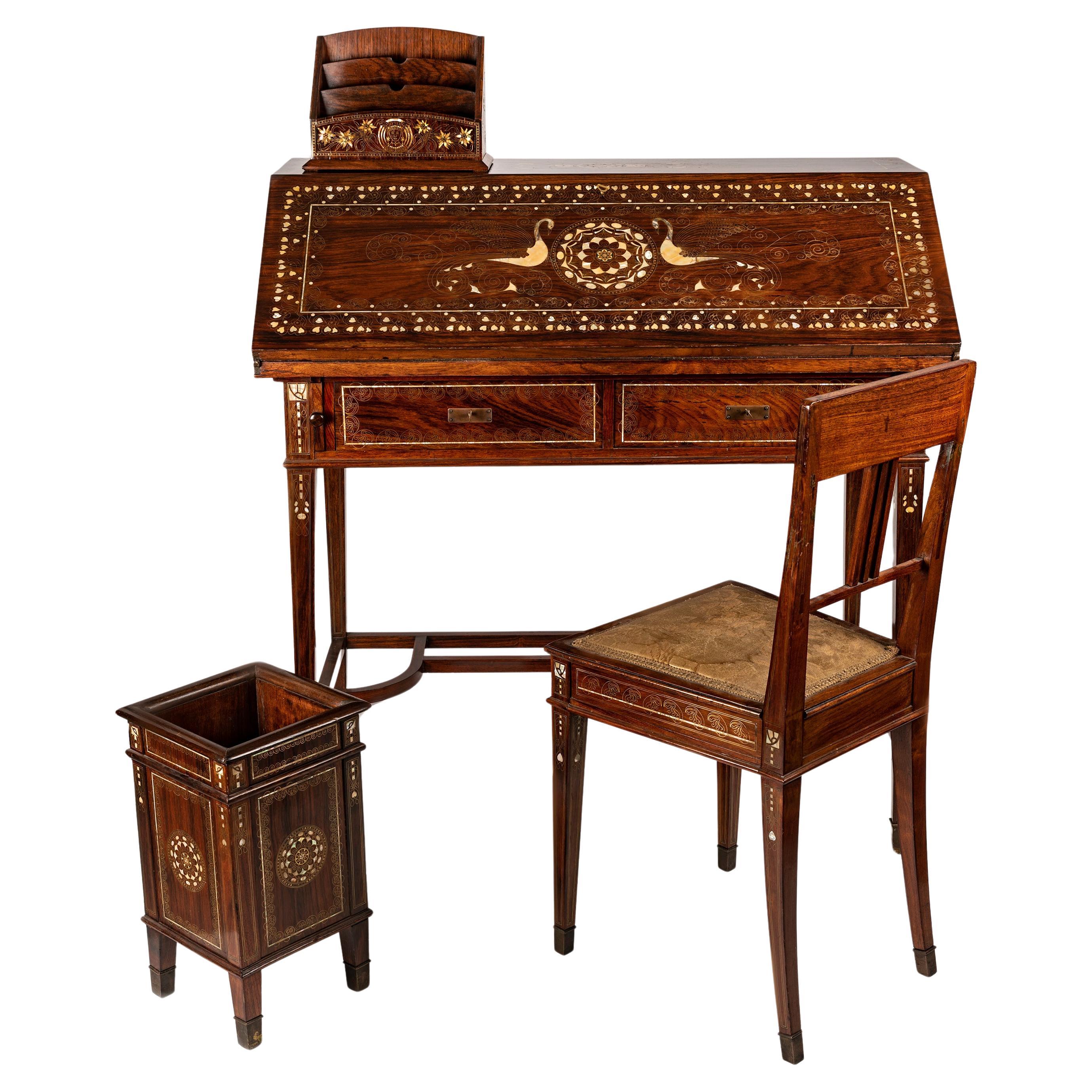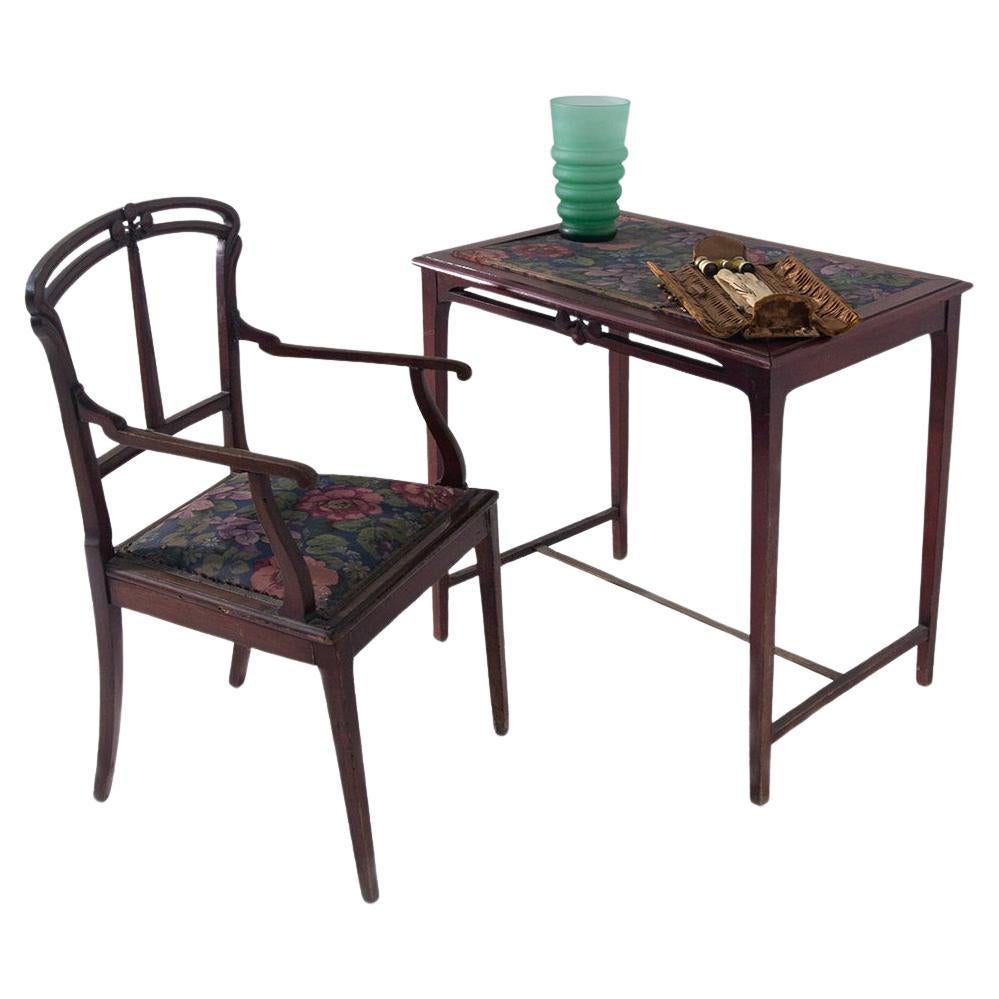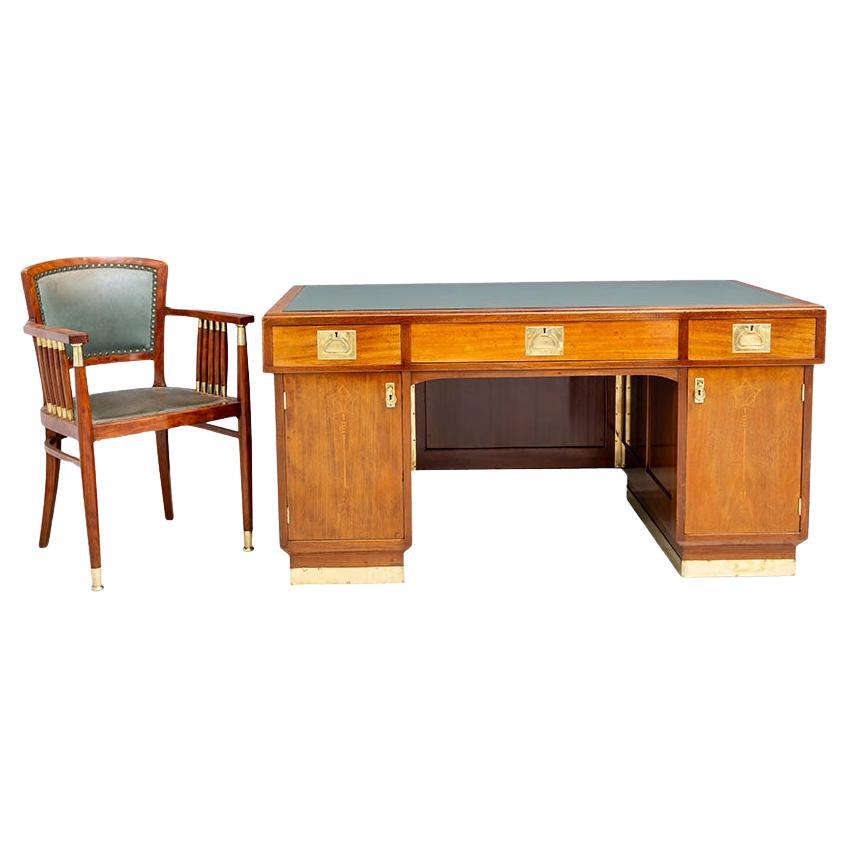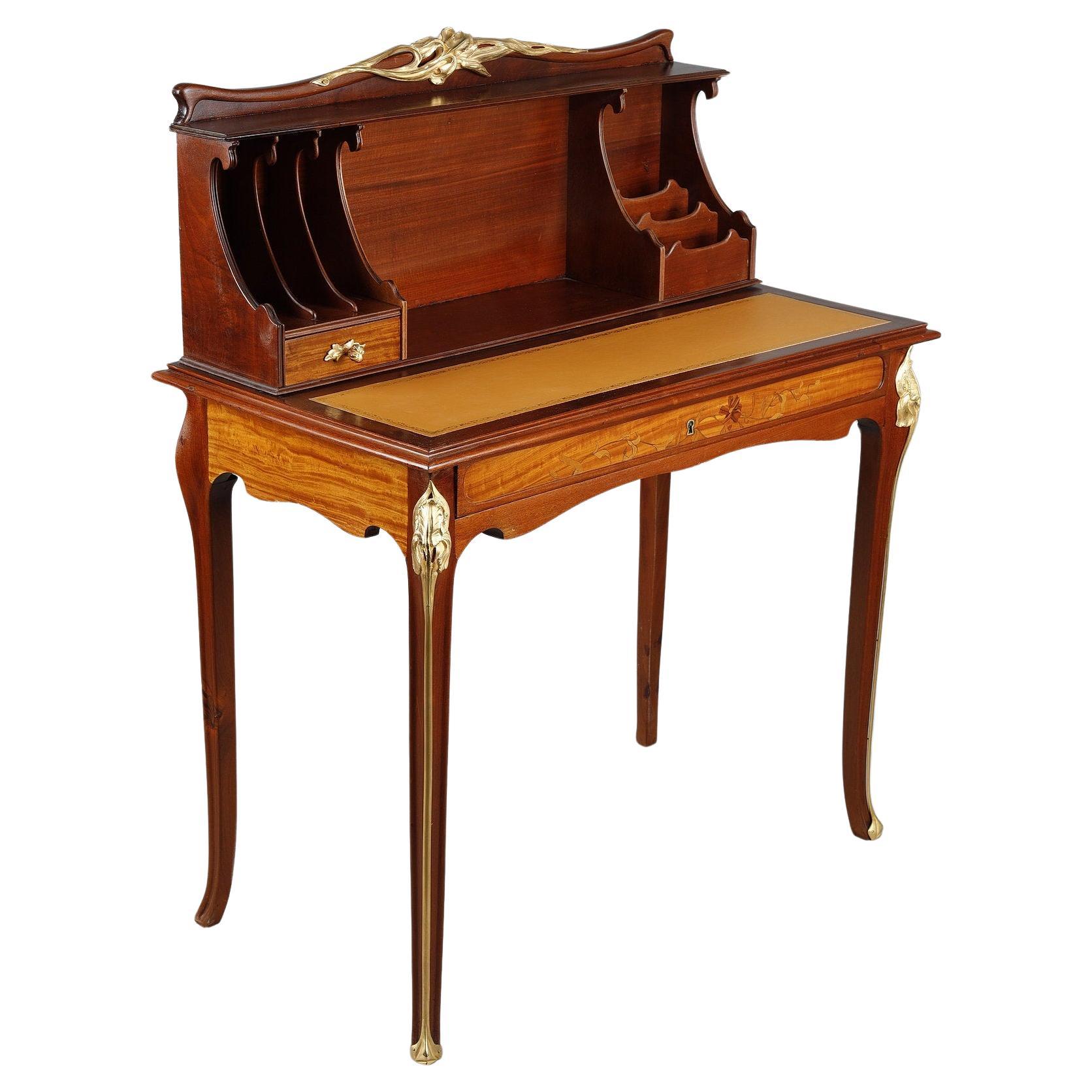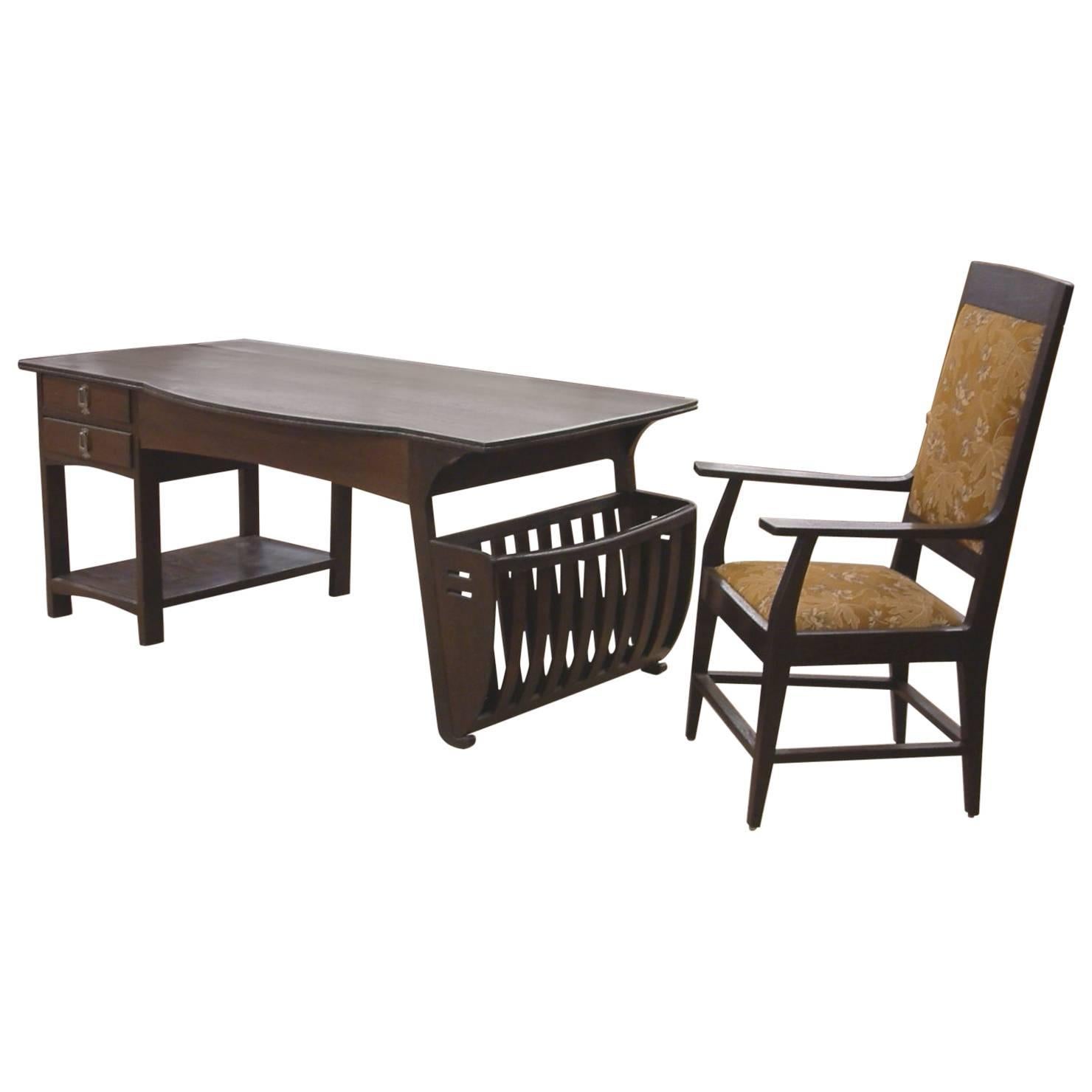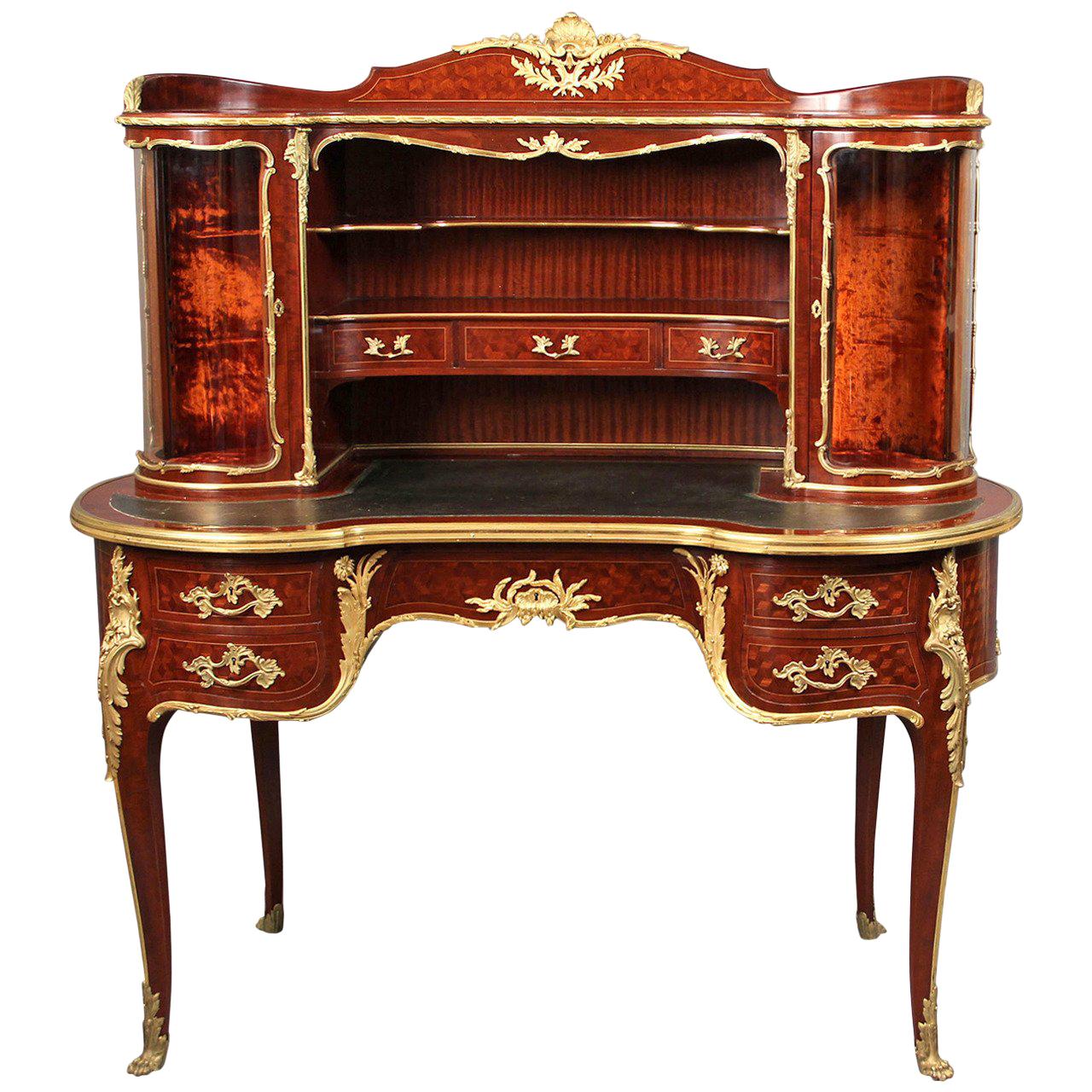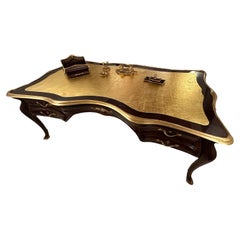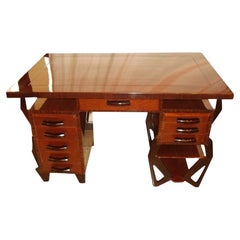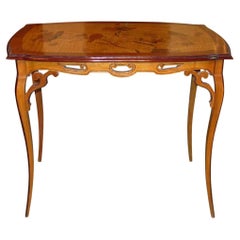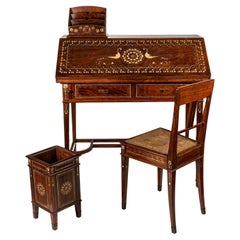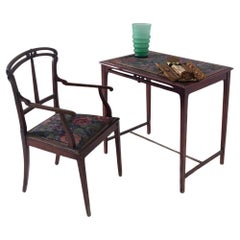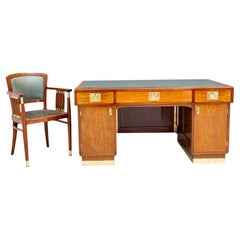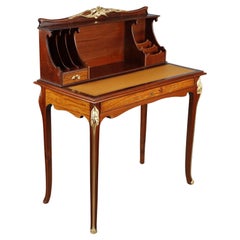Items Similar to Eugenio Quarti desk, Chair and Trah in Style Liberty or Art Nouveau, Jugestails
Video Loading
Want more images or videos?
Request additional images or videos from the seller
1 of 9
Eugenio Quarti desk, Chair and Trah in Style Liberty or Art Nouveau, Jugestails
$210,000per set
£158,005.49per set
€182,546.38per set
CA$296,784.81per set
A$322,250.62per set
CHF 170,655.28per set
MX$3,949,869.42per set
NOK 2,111,926.32per set
SEK 1,995,658.56per set
DKK 1,362,451.23per set
About the Item
Eugenio Quarti (Desk , chair and Trash )
Style: Liberty or Art Nouveau or Modernism or Jugendstil
Furniture realized mainly in inlays of nacre and metallic applications, parchament
bronze ferrules.
We have specialized in the sale of Art Deco and Art Nouveau styles since 1982.If you have any questions we are at your disposal
Pushing the button that reads 'View All From Seller'. And you can see more objects to the style for sale.
Eugenio Quarti was born in Villa d'Almè, a small village in the province of Bergamo, from an artisan family of woodworkers. In 1881, at the age of 14 years old he goes to Paris, where he will learn new techniques and broaden his horizons. In 1886, he returned to Italy and settled in Milan where he worked, for a short period, with Carlo Bugatti and then open his own workshop in via Donizetti 3.
His early works are strongly marked by Bugatti Moorish’s style, but already the exhibition of Turin of 1898 you can see the first signs of Art Nouveau and his personal style. He was always attentive to the quality and originality of his accomplishments, always attentive to every art form. Furniture realized mainly in walnut with inlays of nacre and metallic applications. Develop over time a harmonic elegance of the decor, with thread-like grounds, valuable wood species and inlays and high quality bezels with fine materials (nacre, silver, copper, bronze, pewter, etc.), this characteristic was called "the goldsmith of furniture makers."
In 1900 he participates at the Paris International exposition where he received the "Grand Prix" of the jury. Will participate in a number of other exposures as that of Turin in 1902 and Milan in 1906 where he will receive the "Grand Royal Award" and the "Diploma of gold medal".
Eugenio Quarti worked with the most prestigious architects of his time (Giuseppe Sommaruga, Luigi Broggi, Alfredo Campanini, etc.) well as with the great artists/craftsmen of his time as Alessandro Mazzucotelli. He also worked as a decorator, designing entire furniture for both public and private buildings. It was he who designed the furniture for Palazzo Castiglioni in Milan, Villa Carosio in Baveno, Grand Hotel and Casino in San Pellegrino Terme, Hungaria Palace Hotel in Venice Lido. One of his most significant works were the vessels of the "Bar Camparino", at the entrance site of the Galleria Vittorio Emanuele in Milan. however not disdain also committed less important such as the furniture for Villa Mariani to Bordighera residence of the painter Pompeo Mariani. To its activities before cabinetmaker, decorator and then also join a teaching and become Director of applied art workshop for timber, the Company Umanitaria He was, without doubt, one of the great Italian cabinetmakers of the twentieth century, and some of his furniture is exhibited in various museums around the world, including the Museum of Decorative Arts of Castello Sforzesco in Milan, the Orsay Museum of Parigi, the Wolfsonian Museum Miami, etc. At his death in 1929.
Why are there so many antiques in Argentina?
In the 1880 – 1940 there was a grate wave of immigration encouraged by the periods of war that were taking place.
1st World War took place between 1914 and 1918
2nd World War took place between 1939 and 1945
The immigrants options were New York or Buenos Aires. Tickets were cheap and in Buenos Aires they were welcomed with open arms, as it was a country where everything was still to be done.
Argentina was the country of new opportunities, labour was needed and religious freedom was assured, in many cases the of the family travel first until they were settled and then the rest of the family members join them.
In the immigrant museum “Ellis Island Immigrant Building” in New York you can se the promotional posters of the boats that would take them to a new life.
Between the years 1895 and 1896, Argentina had the highest DGP (gross domestic product) per capita in the world according to the Maddison Historical Statistics index, this situation arose due to the large amount of food being exported to European countries, which were at war.
The Argentinean ships left the port of Buenos Aires with food, but they returned with furniture, clothes and construction elements, (it´s common to see this the old buildings of the historic neighbourhood of San Telmo, the beams with the inscription “Made in England)”, as well as many markets that were built in Buenos Aires, such us the San Telmo Market, whose structure was brought by ship and afterwards assembled in 900 Defensa Street.
With the great influence of European immigrants living in the country, the children of the upper classes travelled to study in France, resulting in the inauguration of “La Maison Argentinienne”, on 27th of June 1928, in the international city of Paris, which hosted many Argentinians that were studying in Frace.
It´s the fourth house to be built after France, Canada and Belgium, being the first Spanish-speaking one. Still in place today (17 Bd Jourdan, 75014, Paris, France). Many of the children of these wealthy families who attended international art exhibitions, museums and art courses abroad, took a keen interest in the European style. This is why Buenos Aires was at the time referred as “The Paris of South America”.
Between the years 1890 and 1920 more than a hundred Palaces were built on Alvear Avenue the most exclusive avenue in Buenos Aires. Today some of these palaces have been transformed into museums, hotels and embassies.
In the year 1936, the Kavanagh building was inaugurated, it was the tallest reinforced concrete building in South America.
During 1994 the American Society of Civil Engineers distinguished it as an “international engineering milestone”, and it´s now considered a World Heritage of Modern Architecture.
At the time was common to hire foreign architects such as Le Corbusier, who visited Buenos Aires/Argentina in 1929 and in 1948 he drew up the blueprints for a house built in La Plata City (which was declared a World Heritage Site).
In 1947, the Hungarian architect Marcelo Breuer designed “Parador Ariston” in the seaside city of Mar del Plata. After an Argentinean student at Harvard University convinced him to come to Argentina. He worked on an urban development project in the Casa Amarilla, area of La Boca.
The Ukrainian architect, Vladimiro Acosta, arrives in Argentina in 1928 and worked as an architect until que moved to Brazil.
Antonio Bonet, a Spanish architect who worked with Le Corbusier in Paris, arrives in Argentina in 1937, where he carried out several architectural works and in 1938 designs the well-known BFK chair.
Andres Kálnay, of Hungarian origin, made around 120 architectural masterpieces, among which the former Munich brewery stands out, he even made the furniture’s design.
The German architect, Walter Gropius, director of the Bauhaus, lived in Argentina, where he wrote articles for “Sur” magazine and founded in Buenos Aires, an architectural firm with Franz Möller, who was also an architect, where he built two houses.
At the same time several famous designers decided to immigrate to Argentina, among them we can find the well-known French designer, Jean-Michel Frank, who arrived in the country in 1940 and also worked for the Rockefeller family.
Special pieces were made, which were sold exclusively in the country, such as the well-known German company “WMF”, who sold their products by catalogue, which were chosen by the ladies of high society in the list of wedding gifts, as well as the pieces designed by Christofle.
The Swiss sculptor Alberto Giacometti, made special pieces for Argentinean mansions.
In 1904 the first Jansen branch outside Paris was established in Buenos Aires, as the Argentinean clientele demanded a large amount of furniture, from the end of the 19th century to the mid-20th century.
In 1970, the brand Rigolleau Argentina made pieces authorised by Lalique.
The brands Maple and Thompson also set up shop in the country.
The French plastic artist, Marcel Duchamp moved to Argentina in 1918-1919.
Glass signed Gallé, Charder, Leverre, Schneider, Muller and other French firms. They were bought in flower shops and were given to ladies with beautiful floral arrangements.
Some furniture manufacturers travelled to international fairs and bough the patterns to produce the furniture in Argentina, such as the furniture firm Englander and Bonta, who bought the patterns ins Italy.
It is worth mentioning that in Argentina we have the largest community of Italians outside of Italy, as it is estimated that 70 percent of the inhabitants have at least one Italian descendant, followed by Spanish immigrants.
The most Important furniture stores in Argentina:
Comte is founded in 1934 (under the direct management of Jean Michel Frank in 1940).
Nordiska (Swedish company established in 1934).
Churba in 1960, a company that brought foreign designers to present their furniture in the country:
Denmark: (Arne Jacobsen, Finn Juhl, Bender Madsen, Ejner Larsen, Poul Kjaerholm, Hans Wegner)
Sweden: (Hans Agne Jakobsson, Gustavsberg)
United States: (Herman Miller)
Finland: (Lisa Johansson, Folke Arstrom, Tapio Wirkkala, Alvar Aalto, Timo Sarpaneva)
Swedish Factory: (Orrefors)
Italy: (Littala, Vico Magistretti, Emma Gismondi, Gae Aulenti, Angelo Mangiarotti, Elio Martinelli, Gianna Celada, Angelo Mangiarotti, Mario Bellini, Carlo Scarpa)
Finland: (Olivia Toikka)
Plata Lappas (Lappas Silver): a goldsmith shop founded in 1887 in Argentina by Alcibiades Lappas of Greek origin.
In 2019, in Argentina took place “the Art Deco world congress”, in which we participated as hosts invited by Geo Darder, founder of the Copperbridge – Foundation, in which prominent people from all over the world attended to learn about Art Deco in Argentina.
Argentina currently has more than 100 Art Deco buildings and another 90 Art Nouveau buildings throughout the city of Buenos Aires.
Argentina is a country that has not been involved in many wars, which is why it has been a refuge for works of art and antiques from different periods of time, unlike European countries. That is way many collectors, museums and antique dealers from all over the world visit it, you should not miss the opportunity to visit this great country.
Laura Guevara Kjuder, architect.
- Creator:Eugenio Quarti (Designer)
- Dimensions:Height: 40.95 in (104 cm)Width: 35.83 in (91 cm)Depth: 18.9 in (48 cm)
- Sold As:Set of 3
- Style:Art Nouveau (Of the Period)
- Materials and Techniques:
- Place of Origin:
- Period:1900-1909
- Date of Manufacture:1900
- Condition:Wear consistent with age and use.
- Seller Location:Ciudad Autónoma Buenos Aires, AR
- Reference Number:Seller: F-CA-1061stDibs: LU6785228628572
About the Seller
5.0
Vetted Professional Seller
Every seller passes strict standards for authenticity and reliability
Established in 1982
1stDibs seller since 2022
39 sales on 1stDibs
Typical response time: <1 hour
- ShippingRetrieving quote...Shipping from: Ciudad Autónoma Buenos Aires, Argentina
- Return Policy
Authenticity Guarantee
In the unlikely event there’s an issue with an item’s authenticity, contact us within 1 year for a full refund. DetailsMoney-Back Guarantee
If your item is not as described, is damaged in transit, or does not arrive, contact us within 7 days for a full refund. Details24-Hour Cancellation
You have a 24-hour grace period in which to reconsider your purchase, with no questions asked.Vetted Professional Sellers
Our world-class sellers must adhere to strict standards for service and quality, maintaining the integrity of our listings.Price-Match Guarantee
If you find that a seller listed the same item for a lower price elsewhere, we’ll match it.Trusted Global Delivery
Our best-in-class carrier network provides specialized shipping options worldwide, including custom delivery.More From This Seller
View AllDesk Jugendstil, Art Nouveau, Liberty , Sign: G. Keller Orfevre, 22 rue Joubert
Located in Ciudad Autónoma Buenos Aires, C
The set includes, armchair, desk and desk accessories. It is from the first era.
Bibliography: Revue de l’Art N°185 – March 2014, p. 23.
Founded in 1857 by Gustave Keller, the Keller...
Category
Early 20th Century French Art Nouveau Desks and Writing Tables
Materials
Bronze
Desk Jugendstil, Art Nouveau, Liberty , 1900, France, Wood
By Louis Majorelle
Located in Ciudad Autónoma Buenos Aires, C
Desk
Style: Art Nouveau or Modernism or Jugendstil
Year: 1900
Materials :wood.
We have specialized in the sale of Art Deco and Art Nouveau styles since 1982.If you have any question...
Category
Antique Early 1900s French Art Nouveau Desks and Writing Tables
Materials
Wood
Table Jugendstil, Art Nouveau, Liberty , Year: 1900, Signature: Galle
Located in Ciudad Autónoma Buenos Aires, C
Table Jugendstil, Art Nouveau, Liberty
Year: 1900
Country: France
Wood
It is an elegant and sophisticated table.
We have specialized in the sale of Art Deco and Art Nouveau styles ...
Category
Antique Early 1900s French Art Nouveau Center Tables
Materials
Wood
Table Maison L´art Nouveau, Bing Atelier Magasins, Siegfried Bing, Art Nouveau
Located in Ciudad Autónoma Buenos Aires, C
Incredible Art Nouveau table. With the original label, from Siegfried Bing's or Samuel Bing shop.
We have specialized in the sale of Art Deco and Art Nouveau and Vintage styles since 1982. If you have any questions we are at your disposal.
Pushing the button that reads 'View All From Seller'. And you can see more objects to the style for sale.
L'art Nouveau Bing, Atelier Magasins sold many pieces to the Louvre museum.
It was the most revolutionary store of the time.
It was located at 22 rue de Provence, Paris.
If you want a unique Art Nouveau piece, this should be your choice.
We have specialized in the sale of Art Deco and Art Nouveau styles since 1982.If you have any questions we are at your disposal.
Pushing the button that reads 'View All From Seller'. And you can see more objects to the style for sale.
the Maison de l'Art Nouveau ("House of New Art"), abbreviated often as L'Art Nouveau, and known also as Maison Bing for the owner, was a gallery opened on 26 December 1895, by Siegfried Bing at 22 rue de Provence, Paris.
The building was designed by the architect Louis Bonnier (1856–1946).[2] Unlike his earlier stores at the same location and nearby at 19 rue Chauchat that specialized in Japanese and Asian art objects, the gallery specialized in modern art.[1][3] The original exhibition featured windows designed by Nabi artists, including Henri de Toulouse-Lautrec, and made by Louis Comfort Tiffany...
Category
Antique Early 1900s French Art Nouveau Side Tables
Materials
Wood
Desk in Wood, 1900, Made in France
Located in Ciudad Autónoma Buenos Aires, C
It is an elegant and sophisticated dream desk.
The quality of the furniture and the exotic wood used make it unique. It is an icon of distinction.
You want to live in the golden yea...
Category
Antique Early 1900s French Louis XVI Desks and Writing Tables
Materials
Bronze
Desk in Wood, 1940, Made in France
Located in Ciudad Autónoma Buenos Aires, C
It is an elegant and sophisticated dream desk.
The quality of the furniture and the exotic wood used make it unique. It is an icon of distinction.
You want to live in the golden yea...
Category
Vintage 1940s Italian Art Nouveau Desks and Writing Tables
Materials
Bronze
You May Also Like
Eugenio Quarti Liberty Desk Suite w/ Chair & Paperbasket, Italy, Early 20th c.
By Eugenio Quarti
Located in BARCELONA, ES
A rare complete writing desk suite by Eugenio Quarti, a leading figure of Milan’s Liberty style in the early 20th century. The slant-front secrétaire, matching side chair and wasteba...
Category
Early 20th Century Italian Art Nouveau Desks and Writing Tables
Materials
Brass
Italian Art Nouveau style desk and chair set
Located in Milano, IT
Italian Art Nouveau set from the early 1900s - Elegant carved wooden desk and chairs with floral inserts and original upholstery
Rare and elegant Italian desk set dating from the ea...
Category
Antique Early 1900s Italian Art Nouveau Desks and Writing Tables
Materials
Fabric, Wood
$4,189 / set
Viennese Jugendstil desk and armchair J.W. Müller ca. 1905
By J.W. Müller
Located in Klosterneuburg, AT
Table dimensions: H 78 cm x W 152.5 cm x D 83 cm Armchair: H 90 cm x W 58 cm x D 52 cm
The K. u. K. Hoftischlerei J. W. Müller was one of the leading workshops. It regularly prese...
Category
20th Century Austrian Art Nouveau Desks and Writing Tables
Materials
Mahogany
Art Nouveau Mahogany stepped desk
Located in Paris, FR
Elegant stepped desk in mahogany and mahogany veneer. Gilt bronze frame opening with a drawer inlaid with leaf and flower stems. The front features a draw...
Category
Antique 1890s French Art Nouveau Desks and Writing Tables
Materials
Mahogany
Belgian Art Nouveau Desk and Armchair
Located in Philadelphia, PA
Belgian Art Nouveau desk and armchair in ebonized oak, circa 1905, in the manner of Gustave Serrurier-Bovy. 72" long x 37" deep x 30" high. The Art...
Category
Antique Early 1900s Belgian Art Nouveau Desks and Writing Tables
Rare and Very Special Late 19th Century Bureau by François Linke
By François Linke
Located in Long Island City, NY
A Rare and Very Special Late 19th Century Louis XV Style Gilt Bronze Mounted Two Tier Kidney Shaped Bureau By François Linke
François Linke
The upper case with shaped top, surmount...
Category
Antique Late 19th Century French Belle Époque Desks and Writing Tables
Materials
Bronze, Ormolu
More Ways To Browse
Art Nouveau Marquetry
Art Nouveau Marquetry Table
Mid Century Modern Office Trash Can
Italian Marquetry Desk
Liberty Desk
San Pellegrino
Antique 2 Drawer Side Table With Brass
Antique and Vintage School Desks
Architects Table Mahogany
Bank Desk
Blue Lacquer Desk
Cabriole Leg Desk
Campaign Tables With Brass
Carlton House Writing Desk
Desk War
Gustav Stickley Copper
Gustav Stickley Desk
Japanese Wood Desk
